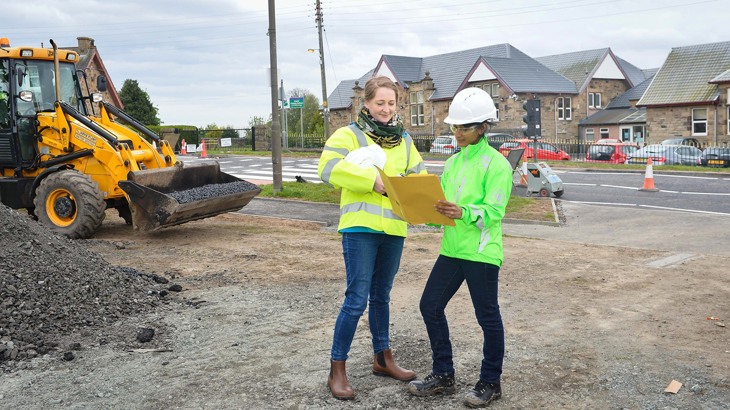The way we interact with towns and cities is going to change, and the construction sector is well placed to facilitate this through the repurposing of spaces to allow for social distancing, which will be with us long after the various restriction regimes are lifted. Joseph Kilroy from the Chartered Institute of Building (CIOB) in Ireland tells us how.

The Covid-19 pandemic has led to widespread critical reflection on public life, and a welcome reassessment of our use of space, particularly in towns and cities.
The success of the transition to remote working in some sectors has led to scepticism about the need to devote so much space to offices, and time to commuting.
The dawning realisation that offices are not a necessary condition for work, and indeed, due to associated commutes, can impede productivity, may lead to a long-term recalibration of our built environment.
Re-prioritisation of urban space
From a spatial perspective, the impact of Covid-19 has led to a new hierarchy of needs emerging in cities, and infrastructure will evolve to reflect this.
Tolerance for devoting large swathes of valuable urban space to offices filled with employees who could work remotely will be low.
Particularly considering the well-documented difficulties for key workers to find appropriate housing close to their workplace.
It will be difficult to accommodate space-hungry traffic congestion in the context of social distancing, whereas public spaces that facilitate social distancing are now a must from a public health perspective.
Moving away from car-dependent development
The lockdown has also shown tangible gains in terms of reduced carbon emissions, and cleaner air in cities.
The public will want to preserve these gains.
The built environment can lead on this by encouraging a move away from car-dependent development while facilitating sustainable transport infrastructure.
Space has been reclaimed for pedestrians and cyclists, with streets being pedestrianised and bike shops recording record sales as the 2020 ‘cycling boom’ gathers pace.
Now that people have been given a glimpse of what it is like to live in towns and cities that prioritise sustainable transport infrastructure, it is unlikely that they will want to give up these gains and revert to less efficient uses of space if restrictions are completely lifted.
Environmental groups like Sustrans have long argued for the negative quality of life implications of continuing to inefficiently devote space to private cars and on-street parking.
Now the issue has national, even global implications.
If we continue to squeeze pedestrians and cyclists into small spaces by disproportionately devoting space to private cars, we are putting the public’s health at immediate risk through Covid-19 transmission.
The Construction Sector
While this spatial evolution happens in towns and cities, the construction industry is equipping itself to deliver the kinds of infrastructure that our new circumstances demand.
As the restrictions are lifted in the coming weeks, there are two questions facing the construction sector.
What is in the post-Covid-19 project pipeline, and how will sites operate?
In the normal run of things, the construction industry is very safety conscious.
It operates under strict rules of health and safety, and as such is well placed to police itself through new regulations and additional enforcement.
Cities evolving infrastructure requirements crucial to the industry
In terms of the pipeline of activity, most construction projects have been impacted by COVID-19.
This brings uncertainty, which is anathema to the sector.
The CIOB’s ‘Real Face of Construction’ report emphasises the role that Government can play in subduing volatility in the sector by providing a clear pipeline of infrastructure projects.
The government can mitigate the uncertainty Covid-19 has wrought in its capacity as a client.
The evolving infrastructure requirements of cities will be a crucial part of the pipeline of activity that will see construction re-emerge from the crisis.
There is already repurposing work happening in towns and cities to make them more pedestrian, cycle, and social distancing friendly.
Construction – specifically repair, maintenance and improvement (RMI) work – is delivering this.
In the immediate term, there is a clear case for an infrastructure pipeline centred on repurposing towns and cities, providing sustainable transport infrastructure, and social distancing-friendly spaces.
These socially valuable, labour intensive RMI projects have the dual benefit of providing a stable pipeline of work and creating a built environment fit for the future.
Proposed investment in the Republic of Ireland
The sizeable increase in spend on cycling and walking (360 million euros per year) proposed in the Republic of Ireland’s programme for government, published in June this week, reflects this new reality.
As do the new pop-up cycle lanes introduced in Belfast by Northern Ireland’s Minister for Infrastructure, Nichola Mallon.
Many local authorities are reimagining their local areas to be more pedestrian and cycle-friendly in preparation for the new social distancing reality we will face when we fully emerge from the lockdown.
Take a look at our Space to move map and see what local authorities are doing to make it easier for people to move around safely during the lockdown and beyond.

With thanks to our guest blogger Joseph Kilroy, Chartered Institute of Building (CIOB) Ireland.





